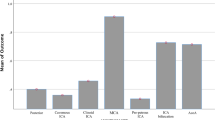Abstract
This study aims to investigate the long-term outcomes of unruptured giant intracranial aneurysms (GIAs) with different treatment modalities and to analyze the factors affecting prognosis. We performed a retrospective medical record review of patients with unruptured GIAs treated at our institution from 2011 to 2018. Prognosis was compared to the best medical treatment without intervention (conservative treatment, CT) and surgical (ST) or endovascular (ET) treatment. Risk factors for mortality were investigated. A total of 276 patients were included in this study. Patients received CT in 16.3%, ST in 30.1%, and ET in 53.6% of cases. After an average 7-year follow-up, the rupture rate after CT was 22.2%, accounting for an annual rupture rate of 7.3%. The postoperative complication rate was 30.1% and 8.1% after ST and ET, respectively. The recurrence rate after ET was 10.1%, compared with ST which was 1.2%. The follow-up mortality in unruptured GIAs was 26.7% after CT, 7.2% after ST, and 5.4% after ET. Older age (50~59, HR 5.877; 60~69, HR 8.565), size ≥ 40 mm (HR 3.916), and posterior circulation location (HR 6.411) were associated with increased mortality. ET significantly decreased mortality (HR 0.191). Unruptured GIAs warrant treatment if feasible due to the high rupture rate and mortality of the natural history. Older age, posterior circulation location, and larger size are risk factors for poor prognosis. Both ST and ET showed a lower mortality rate than CT. ST showed less likely recurrence compared to ET, while ET had a lower complication rate than ST.


Similar content being viewed by others
References
Brisman JL, Song JK, Newell DW. Cerebral aneurysms. N Engl J Med. 2006;355(9):928–39. https://doi.org/10.1056/NEJMra052760.
Investigators UJ, Morita A, Kirino T, Hashi K, Aoki N, Fukuhara S, et al. The natural course of unruptured cerebral aneurysms in a Japanese cohort. N Engl J Med. 2012;366(26):2474–82. https://doi.org/10.1056/NEJMoa1113260.
Wiebers DO, Whisnant JP, Huston J 3rd, Meissner I, Brown RD Jr, Piepgras DG, et al. Unruptured intracranial aneurysms: natural history, clinical outcome, and risks of surgical and endovascular treatment. Lancet. 2003;362(9378):103–10. https://doi.org/10.1016/s0140-6736(03)13860-3.
Brown RD Jr, Broderick JP. Unruptured intracranial aneurysms: epidemiology, natural history, management options, and familial screening. Lancet Neurol. 2014;13(4):393–404. https://doi.org/10.1016/S1474-4422(14)70015-8.
Sughrue ME, Saloner D, Rayz VL, Lawton MT. Giant intracranial aneurysms: evolution of management in a contemporary surgical series. Neurosurgery. 2011;69(6):1261–70; discussion 70-1. https://doi.org/10.1227/NEU.0b013e31822bb8a6.
Peschillo S, Caporlingua A, Resta MC, Peluso JPP, Burdi N, Sourour N, et al. Endovascular treatment of large and giant carotid aneurysms with flow-diverter stents alone or in combination with coils: a multicenter experience and long-term follow-up. Oper Neurosurg (Hagerstown). 2017;13(4):492–502. https://doi.org/10.1093/ons/opx032.
Dengler J, Rufenacht D, Meyer B, Rohde V, Endres M, Lenga P et al. Giant intracranial aneurysms: natural history and 1-year case fatality after endovascular or surgical treatment. J Neurosurg. 2019;1–9. https://doi.org/10.3171/2019.8.JNS183078.
Hetts SW, Narvid J, Sanai N, Lawton MT, Gupta N, Fullerton HJ, et al. Intracranial aneurysms in childhood: 27-year single-institution experience. AJNR Am J Neuroradiol. 2009;30(7):1315–24. https://doi.org/10.3174/ajnr.A1587.
David CA, Vishteh AG, Spetzler RF, Lemole M, Lawton MT, Partovi S. Late angiographic follow-up review of surgically treated aneurysms. J Neurosurg. 1999;91(3):396–401. https://doi.org/10.3171/jns.1999.91.3.0396.
Rosenbaum PR. Constructing a control group using multivariate matched sampling methods that incorporate the propensity score: the American Statistician. Am Stat. 1985;39(1).
Xu L, Deng X, Wang S, Cao Y, Zhao Y, Zhang D, et al. Giant intracranial aneurysms: surgical treatment and analysis of risk factors. World Neurosurg. 2017;102:293–300. https://doi.org/10.1016/j.wneu.2017.03.055.
Dengler J, Maldaner N, Glasker S, Endres M, Wagner M, Malzahn U, et al. Outcome of surgical or endovascular treatment of giant intracranial aneurysms, with emphasis on age, aneurysm location, and unruptured aneuryms--a systematic review and meta-analysis. Cerebrovasc Dis. 2016;41(3–4):187–98. https://doi.org/10.1159/000443485.
Availability of Data and Material
The data that support the findings of this study are available from the corresponding author upon reasonable request.
Funding
This study is supported by National Key Technology Research and Development Program of the Ministry of Science and Technology of China (2015BAI12B04), Beijing Science and Technology Supporting Plan (D16110000381605), Beijing Municipal Administration of Hospitals’ Mission Plan (SML20150501), and National Natural Science Foundation of China (81571110, 81771234).
Author information
Authors and Affiliations
Contributions
JL designed the study, wrote the manuscript, researched the data, and contributed to the discussion. ML designed the study, contributed to the discussion, and edited the manuscript. JB, YLZ, YL, XC, and YZ contributed to the discussion and edited the manuscript. JZ designed the study, researched the data, reviewed/edited the manuscript, and contributed to the discussion.
Corresponding author
Ethics declarations
Conflict of Interest
The authors declare that they have no conflict of interest.
Ethics Approval
This study was approved by the Beijing Tiantan Hospital Research Ethics Committee.
Informed Consent
Informed consent was obtained from all individual participants included in the study.
Additional information
Publisher’s Note
Springer Nature remains neutral with regard to jurisdictional claims in published maps and institutional affiliations.
Electronic supplementary material
ESM 1
(DOCX 20 kb)
Rights and permissions
About this article
Cite this article
Lu, J., Li, M., Burkhardt, JK. et al. Unruptured Giant Intracranial Aneurysms: Risk Factors for Mortality and Long-Term Outcome. Transl. Stroke Res. 12, 593–601 (2021). https://doi.org/10.1007/s12975-020-00861-6
Received:
Revised:
Accepted:
Published:
Issue Date:
DOI: https://doi.org/10.1007/s12975-020-00861-6




